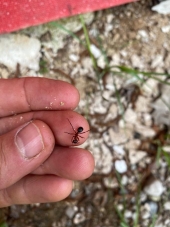I had a talk with the guy who was supposed to cover my roof with reeds. He was drunk and without inhibitions let loose his doubts about my way of building my roof and it added uncertainty to my situation going forward.
I would like advice on:
Should I continue trying to build a reed thatched roof or consider an alternative?
and
If I go another route, what are my roofing options on an uneven roof?
My Roof Situation
My goal is to build a house from sustainable materials as much as possible without nails. Last Fall, was year 3, when I constructed the roundwood rafters and started building the battens from mostly dry wood found in the pine forest until winter came and I left the structure as is until this Spring. I returned to find an abundance of green pine, when they cleared that same forest, which I thought suitable for battens, thus I built the remainder of the front side of the roof using only green wood.
Here are the problems the guy mentioned yesterday:
The battens should be perfectly even from one to the next all the way up the roof. Mine are not aka the roof is wavyGreen wood will warp when it driesHe said: "You should never use dowel joints for a roof construction." Why, I do not know.
Wavy Roof
Having laid down the battens on my first half of the roof, I see why it's helpful to have everything as even as possible and why I've only been able to find information using dimensional rafters, however, I decided to work with what I have and can get access to, plus, building this structure is a learning process for me, full of mistakes and lessons, I couldn't have learned without some kind of experience. He told me last year to try to get it as level as possible and we'd find a way to fix it.
Does anyone have advice how to level a wavy roof or how to work with it?
Green Wood, Warpy Roof with Dowel Joints
Here I posted last year how I constructed the roundwood rafters. The battens are pegged with a 5/8" dried oak peg in each rafter. I drilled halfway into the rafters at each joing, at least 4-5cm deep, drilled offsets, which alternate directions left/right going up the roof and added wedges into both ends of the pegs. I possibly spent the most time on this part of the process.
I would like some additional perspectives. Is there something else I haven't though about that could cause issues,











